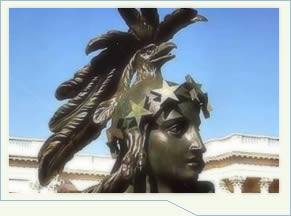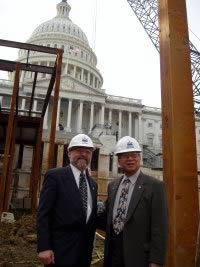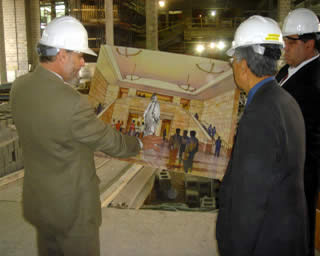
The Statue of Freedom atop the U.S. Capitol Building was erected in 1863, at the height of the Civil War. The dignified proceedings of the installation included a 35-gun salute -- one volley for each state in existence at the time -- rejoined, in turn, by each of the 12 forts that then protected Washington, D.C. The statue's completion and installation demonstrated to a war-torn nation the immutability of personal freedom, and Union: inscribed upon her cast-iron globe base are the words "E Pluribus Unum" -- Out of many, one.
Senator Akaka believes these important sentiments, particularly that of personal freedom, resonate within a world struggling to restore order and peace in the midst of the Global War on Terror, and the country's role in perpetuating freedom and democracy throughout the globe. This is one of many aspects that hold particular weight for Senator Akaka. "As our country continues to lead the world in the universal pursuit of freedom and democracy, we look to Lady Freedom for her constant inspiration -- to bolster us in our mutual efforts toward these great ideals," said Senator Akaka. "She stands as a noble reminder to the world of the fundamental principles that make our country great."  Senator Akaka has worked actively to foster greater understanding of Lady Freedom's significance by encouraging greater visibility of the Statue's plaster model. He remains committed to the dissemination of Freedom's underlying philosophy. The model had been cut in two and had been in storage in pieces since 1965, when under Senator Akaka's leadership Congress authorized the Architect of the Capitol to accept donations for its restoration and display. The pieces of the model, which had all been saved, were moved to the rotunda of the Russell Senate Office Building and put back together. The plaster surface was repaired and repainted by Architect of the Capitol craftsman, with advice from a sculpture conservator. In January 1993, the model became available for public viewing. Senator Akaka continues to work with the Architect of the Capitol and Secretary of the Senate to display the model in a prominent location in the Capitol Visitors Center, which is currently under construction. Senator Akaka has worked actively to foster greater understanding of Lady Freedom's significance by encouraging greater visibility of the Statue's plaster model. He remains committed to the dissemination of Freedom's underlying philosophy. The model had been cut in two and had been in storage in pieces since 1965, when under Senator Akaka's leadership Congress authorized the Architect of the Capitol to accept donations for its restoration and display. The pieces of the model, which had all been saved, were moved to the rotunda of the Russell Senate Office Building and put back together. The plaster surface was repaired and repainted by Architect of the Capitol craftsman, with advice from a sculpture conservator. In January 1993, the model became available for public viewing. Senator Akaka continues to work with the Architect of the Capitol and Secretary of the Senate to display the model in a prominent location in the Capitol Visitors Center, which is currently under construction.
Physical Form By artist Thomas Crawford, the Statue of Freedom is one of America's most enduring and poignant symbols of democratic government. She stands 19'6" tall above its base on the Capitol dome and weighs an impressive 14,985 pounds. You can see some very classically Greek and Roman elements in place upon closer inspection of Freedom. Her left hand, which rests upon the shield of the United States, holds a laurel wreath, symbolizing triumph and honor. A sheathed sword, representing peace, lies grasped in her right, ready to be drawn if needed. The pedestal is embellished with wreaths and fasces, which are bundles of rods symbolizing governmental authority. The Statue's headdress is perhaps her most controversial feature. It is a Roman helmet ringed by stars, and a crest consisting of an eagle's head, feathers and talons. Secretary of War Jefferson Davis, who oversaw the design of Freedom, objected to Crawford's model of the Statue wearing a liberty cap, the symbol of French revolutionaries and freed slaves in ancient Rome. On the matter, he wrote: "...history renders it inappropriate to a people who were born free and would not be enslaved." A re-design by Crawford complied with the Secretary's wishes for a helmet to represent strong defense. For more information on the Statue of Freedom and other Capitol attractions, please visit the Architect of the Capitol's website. Akaka Gets Personal Tour of the Capitol Visitor Center  On May 16, 2005, Senator Akaka received a personal guided tour, led by Architect of the Capitol Alan Hantman, of the construction site for the new Capitol Visitor Center on the grounds of the U.S. Capitol. The CVC, scheduled to open in Fall 2006, will add 70 percent more space or 580,000 square feet in exhibition and meeting space to the Capitol Complex. This represents the largest expansion of the Complex in our country's long history. The CVC will accommodate roughly 4,000 to 5,000 visitors at a time, compared to the approximately 2,000 people per hour that can currently be taken through the Capitol at any time. Senator Akaka viewed areas of the site which will become new entrance and screening areas, orientation theaters, a Great Hall, a Congressional auditorium, and extensive exhibition space for educational and historical materials. On May 16, 2005, Senator Akaka received a personal guided tour, led by Architect of the Capitol Alan Hantman, of the construction site for the new Capitol Visitor Center on the grounds of the U.S. Capitol. The CVC, scheduled to open in Fall 2006, will add 70 percent more space or 580,000 square feet in exhibition and meeting space to the Capitol Complex. This represents the largest expansion of the Complex in our country's long history. The CVC will accommodate roughly 4,000 to 5,000 visitors at a time, compared to the approximately 2,000 people per hour that can currently be taken through the Capitol at any time. Senator Akaka viewed areas of the site which will become new entrance and screening areas, orientation theaters, a Great Hall, a Congressional auditorium, and extensive exhibition space for educational and historical materials.
While inspecting the future site of the Great Hall, Mr. Hantman showed Senator Akaka a central location that is being structurally reinforced to accommodate the plaster model of the majestic Statue of Freedom that sits atop the Capitol Dome. The relocation of the model from its current space in the Russell Senate Office Building would mark the fulfillment of a vision that Senator Akaka has pursued for years, in an endeavor to have the model displayed in a better-suited location so that visitors may view it up close and understand the significance of the Statue of Freedom itself. Mr. Hantman also identified space in the Great Hall that could later accommodate the statue of King Kamehameha. The King's statue, one of Hawaii's two statues in the Capitol Building, is currently in a corner of Statuary Hall because more prominent areas of the Capitol Building cannot support the statue's weight. The Great Hall will eventually be able to hold roughly two dozen statues. A selection committee may decide the placement of various displays in the new CVC. Sources The Architect of the Capitol -- Statue of Freedom: http://www.aoc.gov/cc/art/freedom.htm U.S. Capitol Historical Society: http://www.uschs.org/03_education/subs/subs_lessons/02_b.html Allen, William C. History of the United States Capitol: A Chronicle of Design, Construction, and Politics |

